In-Tray or In-Basket Exercise
In this assessment center exercise you will be asked to assume a particular role as an employee of a fictitious organization and to work through a pile of correspondence in your in-tray. The in-tray exercise items will be specifically designed to measure job skills such as: ability to organize and prioritize work; analytical skills; communication with team members and customers; written communication skills; and delegation.
The in-tray exercise is popular because it has considerable 'face validity.' In other words, candidates can see how it relates to the job they are applying for and therefore they tend to take it seriously.
If you have not practiced an in-tray exercise before it is very easy to be overwhelmed by the amount of material you are expected to work through in the time available. At the very least you should practice working through items and classifying them according to their urgency and importance. You will invariably find that there are one or two 'major issues' hidden among the in-tray items and if you miss these you will struggle to remain a credible candidate. This exercise consists of two parts:
1) Reading and assimilating all the information contained in the in-tray items.
2) Answering questions that will judge how well you would perform the role and react to the situations presented.
The format varies according to the type of role but generally you will have between 12-35 items to read through and then answer 15-30 multiple-choice questions. The more senior the role the more complex the issues; in some instances a short written explanation or a verbal explanation of your choices may be required.
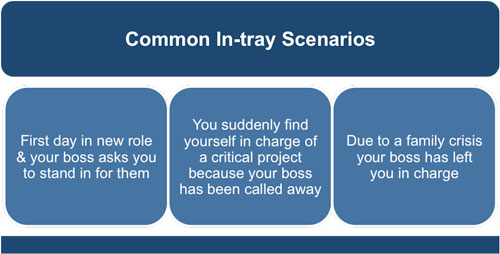 |
The circumstances you are asked to handle will most likely be some sort of emergency or crisis as these situations are best for showing how an individual manager deals with stress and uncertainty.
The more familiar you are with the type of questions you will be asked as part of an in-tray exercise the easier you will find it to display the required behaviors. It is important that you are able to demonstrate that you can:
• Easily identify the 'Key' issue of each item
• Interpret and evaluate the information accurately
• Quickly arrive at a decision
• Explain how your action/decision deals with the problem
Don't make the mistake of worrying about the topic. You will be judged on how well you can handle complex information, determine priorities, make decisions within time limits, display sensitivity to potential problems, and communicate clearly. Try to imagine that you are at work doing the described duties, rather than just completing an exercise, but make sure that the reasons for your actions are clear and documented.
The type of issues you will be asked to review and action will reflect the 'nature' of the role you have applied for. This does not necessarily mean that the scenario will be based on your industry or sector, but it does mean that if you are applying for a strategic role then it is likely that you can expect a significant number of your in-tray items will be designed to test your strategic decision making; whereas if you are hoping for a management role, the in-tray items are more likely to raise issues about team building, coaching, motivation, and other management issues.
Before you begin the in-tray exercise you will be handed several items that are numbered or lettered for easy reference - these will provide you with all of the information you need to complete the exercise. Do not make any assumptions and only use the information provided to arrive at your decisions. If you know that you are going to be given the opportunity to justify your answers, then you may be able to take a few more risks in the decision-making process. However, if you are not going to be given the opportunity to justify your decisions then you should choose the most obviously 'correct' answer.
Be wary of falling into the trap of making a decision or selecting an answer that you would normally want more detailed information about before making. If it is appropriate for the nature of the question - your answer could be 'None of the above,' or 'I'd want to delay my decision until I had more information.'
When you are working through the items in an in-tray exercise always try to be as logical and systematic as possible in the way that you work. The information may be presented in a haphazard way, but you don't want to be seen to work in a haphazard way. Be mindful of how your desk or working area looks during and at the end of the exercise. Always try to present an organized appearance and try and avoid looking as if you are in chaos. Using Post-it notes to identify items and clearly annotating items will greatly enhance your efficiency and help you to keep things under control.
Firstly, you should scan through each of the in-tray exercise items quickly and sort them into chronological order. At the same time, look out for items that are interdependent or items which make a previous item redundant. This is an important step as you don't want to waste time with items which have been superseded and which don't need to be actioned. Also, you may think you have quickly solved one problem only to find that a memo sent three days later has added a further complication, which makes your original decision unworkable or impractical.
For example, you may want to put items into three piles using a Post-it to identify each one - Urgent, Important, and Routine. For each of these piles you may then segregate them further by who is to deal with them - Myself, Delegate (Name), and File, or it could be based on a timeframe - Next Hour, Today, Tomorrow, and Later. If you are using a timeframe as a method of prioritizing then you may wish to use the calendar provided or create your own to make notes on so that you can easily see an overview of the situation.
Use your highlighter to identify key information you have been given:
• Who you are,
• Your function,
• Type of organization (government, industrial, or nonprofit),
• Recipient and how they relate to you,
• Date on the item in relation to 'today's' date
• Dates of meetings and deadlines.
Sometimes details contained in your role overview may consciously try to limit your ability to respond so that the interviewers can assess how you deal with such a situation.
There are eight behaviors you need to demonstrate whilst you perform this exercise and as you consider each one you will be able to ascertain any areas that need further development for the role.
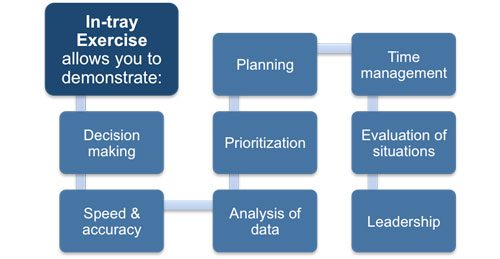 |
Looking at how each of these behaviors is tested in the in-tray or in-basket exercise allows you to judge whether your current performance is at the correct level for the position.
Decision-making - your ability to make well thought-out decisions is paramount to your success. This exercise looks at your ingenuity when resolving problems and making decisions. It assesses what use you made of any other resources that you had at your disposal in the scenario.
It also tests your commercial insight by examining how well your decisions match the organization's culture and needs created by the scenario. Your answers will also indicate how well your management style reflects that of the organization.
For example, A question asks what you would do with a paper copy of an email detailing an old supplier's terms and conditions. Selecting 'Discard' as your answer may be appropriate if you are working in an operational role in manufacturing company, but filing it would be more appropriate if you were in the purchasing department where it is essential such data is held for a fixed period in case of a contractual dispute.
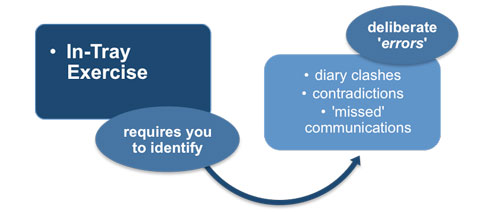 |
Speed and Accuracy - In the type of situations usually used for this exercise where you suddenly have to accept another's workload you need to demonstrate that you can work through the items quickly and efficiently. This judges your ability to work under unexpected stress and maintain high levels of accuracy at the same time. By practicing and becoming familiar with the type of errors frequently used as part of an in-tray exercise (e.g. diary clashes, contradictions, errors, and missed communications) your behavior will demonstrate your ability to take on the unknown.
Analysis of Data - you will be given several different items that detail the circumstances you are presented with as part of this exercise.
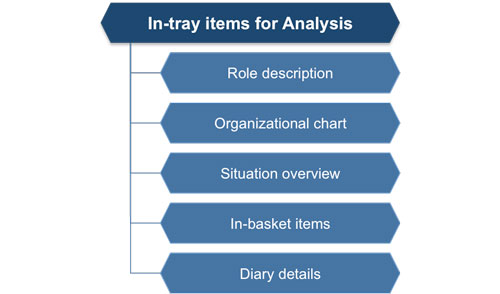 |
You will be judged on your ability to recognize the potential areas of conflict and get to the root of any problem by collating and analyzing details from several in-tray items. If you are tempted to scan some items rather than read them carefully then you will run the risk of missing something important.
Prioritization - is a fundamental part of the decision-making process and the in-tray exercise usually includes several items that are designed to divert your time and effort away from the more important items. You will have to make a value judgment as to whether the task is appropriate for delegation. It is key that you also take account of the organizational goals along with each item's level of importance and urgency. Your answers need to show an appreciation of any external factors and internal resources that impact the priority you assign each item and action. Finally, the priorities you assign must reflect those someone in the role would make and this may be a 'level up' from where you are currently.
Planning - how well you use the resources at your disposal including the skills of your team to ensure that all commitments are kept and met in a timely fashion. It also tests your ability to alter your plan to incorporate additional responsibilities. Your planning skills are reflected in how you answer the questions. You need to show that you have grasped the key issues raised and can develop strategies to accommodate the additional workload.
Time management - it is vital that you are able to show that you can use the time you are given effectively in a structured and productive manner. Make sure you spend the majority of your time on the most important items.
Evaluation of situations - being able to judge the implication of items accurately is essential. This exercise provides the perfect opportunity to demonstrate your ability to analyze the pertinent data from each in-tray item so that you can make sound decisions that suit the circumstances and organization. Even though the situations you are presented with might be unrealistic, you need to take them seriously. Remember you are being assessed on how well you show the required behaviors of the role and this is always easier if you 'buy in' to the exercise as much as possible.
Leadership - it is essential that you combine different styles of leadership throughout the exercise. The issues you are presented with will sometimes require you to be people-orientated and at other times to focus on resolving the situation.
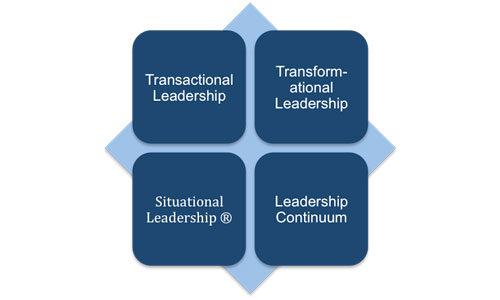 |
Your success in exhibiting this behavior during the exercise depends on the knowledge you have garnered from your research into the organization. The more in depth your research the more easily you will respond in a way that reflects the organization's culture.
In certain circumstances and for particular senior roles the in-tray exercise concludes with a 'justification' discussion. During this discussion remember you are still performing the role assigned to you as part of the exercise. Your answers need to be concise and make your point succinctly as you will only have a few minutes to respond. If the exercise does not include a justification then make sure your notes are readable (maybe print in capitals) by anyone so they can see your reasoning.
Frequently there is a central theme to the in-tray exercise items. This could be an impending takeover, potential merger, management buy-out, re-organization with redundancies, or poor financial performance. Whilst you are reading through the overview and the items provided be mindful of this re-occurring theme. You will not be expected to have specific market or product knowledge, although being up to date on current industry issues may be useful. It's important to focus on how you deal with issues, how you manage the information, and what actions you subsequently take, as this is what you will be scored on.
Your assessors will want to see how you gauge the impact on the organization of your decision, or action, and also the implications this could have on resources and other projects. They will be looking to see what your initial planning stages consist of and how you will monitor and measure their success.
If the exercise involves the opportunity to explain your decisions then you must remember that you are also being assessed in terms of how you handle yourself under 'interrogation' of your work. The assessor will be observing how you respond to criticism and how easily you can be persuaded to alter your decision.
The justification provides you with an excellent opportunity to explain why you prioritized things in the way you did. This may be because of your experience or the type of environment you currently work in. You will also have the opportunity to bring into the discussion the knowledge gained from your research into the organization, its ethos and mission statement.
To summarize, you will be assessed on how persuasive and reasoned your arguments are, how you respond to criticism of your decisions, and how well you interpreted the information provided. The employer is looking to assess how flexible you are, how much conviction you have and how well your management style suits the organization.
You may also be interested in:
Preparing for Interview Exercises | In-Tray or In-Basket Exercise | Role Play Exercise | Group Exercise | Presentation Exercise | Handling the Media Exercise.


